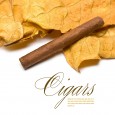Like the rest of Northern Europe, The Netherlands (or Holland) is not a country suitable for the growing of tobacco; however, its people have garnered something of a reputation over the centuries for being experts and connoisseurs of the art of tobacco smoking. Although it was Spanish and Portuguese navigators who first sailed out of Europe and kept going westwards until they “discovered” the Americas and carried back smoking tobacco for the enjoyment of the people back home in Europe.
The Dutch were also a nation of seafarers and it was to be expected that they would try to emulate the colonization examples set by other nations. By the second half of the 17th century; not only was a Dutch Empire being spoken about; but, their ships held some dominance over world trade – along with both the Dutch East India Company and the Dutch West India Company. The names of Dutch navigators like Barents, Hudson and Tasman are remembered today in any world atlas.
With trading established in tobacco growing areas of both Asia and the Americas; it is self evident that finished tobacco products would be produced in Holland. Even today, Dutch brands of pipe and hand rolling cigarette are well known throughout the world, as are some of their small cigars. But, wherever classic, large cigars are talked about; the yardstick is usually the Cuban cigar (even today when many of them are actually made in Nicaragua or the Dominican Republic).
Along with trading wealth, the 17TH Century was also a time when arts flourished in Holland – particularly painting – as evidenced by such as Rembrandt and Vermeer. Therefore, when we speak of the “Old Masters” it is usually these Dutch painters that we have in mind; not the early Dutch cigar makers.
Rembrandt’s De Staalmeesters
In English, this, old master painting is called “The Syndics of the Drapers’ Guild” and it was painted by Rembrandt in 1682 and it has nothing to do with smoking. In fact, smoking (usually of pipes) in Rembrandt’s day was considered something only associated with the lower rungs of society. A fact that makes it hard to understand why the G.H. Johnson Cigar Company in the USA decided to name a new range of products as Dutch Masters Cigars and use a copy of Rembrandt’s painting on their packaging? Nevertheless, that is what they did and the image that they created in 1911; proved so popular that it is still in use today.


